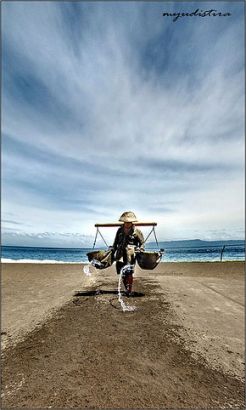The village of Jemeluk near Amed in Karangasem regency now begins to explore and develop their resources in order to compete the neighboring villages such as Amed that have already enjoyed the limelight of tourism for years.
Jemeluk not just offer a beautiful a clean beach free of hawkers and peddlers with stunning sunrise to behold but also a unique traditional salt making activity that have been the main occupation for many inhabitants of Jemeluk for generations. And traditional salt making is the trademark of Jemeluk that is used to give a unique characteristic to the Jemeluk beach.
The traditional salt making activity in Jemeluk is programmed to be a tourist attraction though the activity of salt making can only be seen during the dry season (from April to October), the best time to see this traditional salt making activity is around July and August.


The process of making a salt using traditional Jemeluk technique can be summed up as follow:
First, the seawater is taken from the sea then the seawater is poured on a specially prepared land to increase the salt concentration of the soil after that the soil of field with high salt concentration is leveled in order to allow the soil to dry evenly.
First, the seawater is taken from the sea then the seawater is poured on a specially prepared land to increase the salt concentration of the soil after that the soil of field with high salt concentration is leveled in order to allow the soil to dry evenly.
The drying process usually takes three days then after three days the salty soil is raked and filed into a bamboo cone then the salty soil inside the bamboo cone is pressed by walking on it.
After the salty soil become solid, the seawater is poured into the cone, the salty soil filter the sea water and the filtered sea water that is dripping from the cone is collected in a big palm tree trunk then the filtered sea water is transferred to wooden drying pans made of palm tree trunks. The filtered seawater is allowed to evaporate under hot tropic sun; the seawater evaporates leaving the salt crystals ready to be harvested.
This traditional salt making process can be seen in Hotel Uyah Amed that arranges a daily program of traditional salt making during the dry season.
source:http://blog.baliwww.com





















